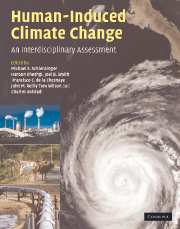Book contents
- Frontmatter
- Contents
- List of contributors
- Preface
- Part I Climate system science
- Part II Impacts and adaptation
- 9 Dynamic forecasts of the sectoral impacts of climate change
- 10 Assessing impacts and responses to global-mean sea-level rise
- 11 Developments in health models for integrated assessments
- 12 The impact of climate change on tourism and recreation
- 13 Using adaptive capacity to gain access to the decision-intensive ministries
- 14 The impacts of climate change on Africa
- Part III Mitigation of greenhouse gases
- Part IV Policy design and decisionmaking under uncertainty
- Index
- Plate section
- References
11 - Developments in health models for integrated assessments
from Part II - Impacts and adaptation
Published online by Cambridge University Press: 06 December 2010
- Frontmatter
- Contents
- List of contributors
- Preface
- Part I Climate system science
- Part II Impacts and adaptation
- 9 Dynamic forecasts of the sectoral impacts of climate change
- 10 Assessing impacts and responses to global-mean sea-level rise
- 11 Developments in health models for integrated assessments
- 12 The impact of climate change on tourism and recreation
- 13 Using adaptive capacity to gain access to the decision-intensive ministries
- 14 The impacts of climate change on Africa
- Part III Mitigation of greenhouse gases
- Part IV Policy design and decisionmaking under uncertainty
- Index
- Plate section
- References
Summary
Introduction
The Energy Modeling Forum (EMF) has facilitated the development of integrated assessment models of economic activity and the resulting anthropogenic emissions, the relevant Earth system responses to the forcings from these emissions, and the costs of policies to mitigate anthropogenic emissions. Initially these integrated assessment models focused solely on the market impacts of climate change. EMF has been a leader in developing cross-disciplinary interactions between integrated assessment modelers and health researchers, with the result that some of the recent developments in population health models arose from the EMF workshops held in Snowmass. The appropriate and robust incorporation of health impacts into integrated assessment models will help policymakers visualize the dimensions of the possible health impacts of climate change and will inform the design of climate and adaptation policy responses.
The current burden of disease due to environmental factors is considerable (WHO, 2002). If trends continue, climate change is very likely to increase the burden of climate-sensitive diseases, including morbidity and mortality due to temperature extremes, extreme weather events (i.e., floods and droughts), air pollution, food- and water-borne diseases, and vector- and rodent-borne diseases; some of these relationships are better understood than others (McMichael et al., 2001). Climate change is one of many factors that will affect the burden of these health outcomes. Significant changes are expected to continue to occur in major factors determining population health, such as per capita income, provision of medical care, obesity, and access to adequate nutrition, clean water, and sanitation.
- Type
- Chapter
- Information
- Human-Induced Climate ChangeAn Interdisciplinary Assessment, pp. 135 - 146Publisher: Cambridge University PressPrint publication year: 2007



